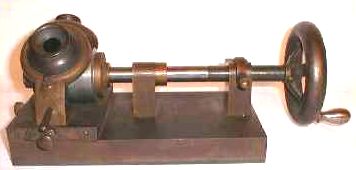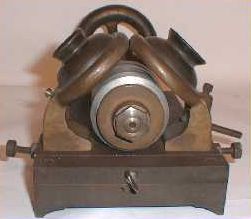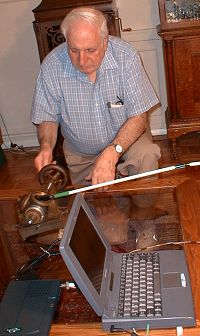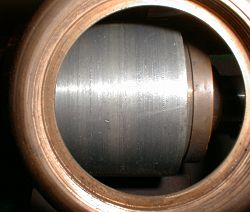
|
|
|
The world earliest playable phonograph recording – voices from 1878 of an experimental talking clock.
| Company | Frank Lambert |
| Cylinder # | Experimental |
| Category | Talking |
| Title | Talking clock |
| Performed by | Frank Lambert |
| Circa | 1878 |
| Announcement | None |
Realizing that soft tinfoil, which was the recording medium of the day,
would not provide a lasting record (wax cylinders were still years away),
Lambert (no relation to Thomas Lambert, inventor of the Lambert celluloid cylinder)
apparently chose to experiment with a cylinder made of lead
For help playing these sounds, click here. |
Notice in the second section, Lambert skips "10 o'clock"!
– The 1878 Lambert phonograph –
 Front view |
 Side view |
Aaron Cramer, discoverer of the 1878 Lambert phonograph, invited Tinfoil.com to his Brooklyn, New York home to transfer and preserve the sound recording from the lead cylinder.
 Aaron Cramer operating the Lambert phonograph, April 1999 |
 Close-up of the lead cylinder |
The recording appears to have been recorded at an average of about 85 revolutions per
Hopefully, clever audio sleuths will be able to smooth out and conquer many of the
mysterious passages of this time
The device is listed in both Guinness Book of World Records and The Encyclopedia of Recorded Sound in The United States as the world's oldest playable phonograph recording.
To learn more about the Lambert phonograph, see Aaron Cramer and Allen Koenigsberg's article (part 1) (part 2) provided courtesy of Collector Cafe.
To hear other examples of wax cylinders, see the
| Home | Early recorded sounds & wax cylinders | Cylinder music shop | An Edison commemorative |
| 2nd page | Note to early recordings collectors | Cylinder of the month | Links to related topics |
| What's new | Tinfoil resource center | Cylinders of the month archive | Donate to Tinfoil.com |